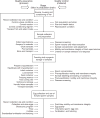Cryopreservation in fish: current status and pathways to quality assurance and quality control in repository development
- PMID: 26739583
- PMCID: PMC5600707
- DOI: 10.1071/RD15388
Cryopreservation in fish: current status and pathways to quality assurance and quality control in repository development
Abstract
Cryopreservation in aquatic species in general has been constrained to research activities for more than 60 years. Although the need for application and commercialisation pathways has become clear, the lack of comprehensive quality assurance and quality control programs has impeded the progress of the field, delaying the establishment of germplasm repositories and commercial-scale applications. In this review we focus on the opportunities for standardisation in the practices involved in the four main stages of the cryopreservation process: (1) source, housing and conditioning of fish; (2) sample collection and preparation; (3) freezing and cryogenic storage of samples; and (4) egg collection and use of thawed sperm samples. In addition, we introduce some key factors that would assist the transition to commercial-scale, high-throughput application.
Figures
References
-
- Aliniya M, Khara H, Noveiri SB, Dadras H. Influence of age of common carp (Cyprinus carpio) broodstock on reproductive traits and fertilization. Turk J Fish Aquat Sci. 2013;13:19–25. doi: 10.4194/1303-2712-V13_1_03. - DOI
-
- Asturiano JF, Sorbera LA, Carrillo M, Zanuy S, Ramos J, Navarro JC, Bromage N. Reproductive performance in male European sea bass (Dicentrarchus labrax, L.) fed two PUFA-enriched experimental diets: a comparison with males fed a wet diet. Aquaculture. 2001;194:173–190. doi: 10.1016/S0044-8486(00)00515-9. - DOI
Grants and funding
LinkOut - more resources
Full Text Sources
Other Literature Sources


